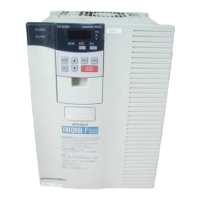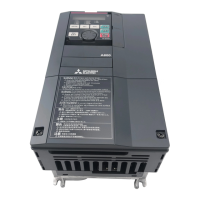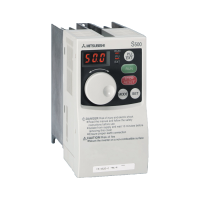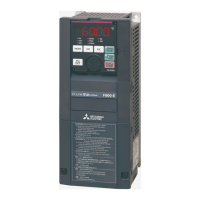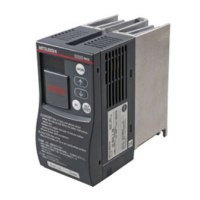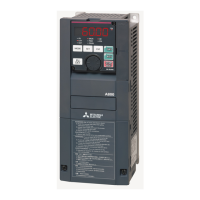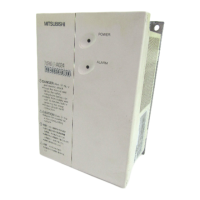101
4
TROUBLESHOOTING
Causes and corrective actions
(3) Alarm
When an alarm occurs, the output is not shut off. You can also output an alarm signal by making parameter setting.
(Set "98" in Pr. 190, Pr. 192 or Pr. 197 (output terminal function selection). Refer to Chapter 4 of the Instruction Manual
(Applied)).
(4) Fault
When a fault occurs, the inverter trips and a fault signal is output.
Operation panel
indication
SA
FR-PU04
FR-PU07
——
Name Safety stop
Description Appears when safety stop function is activated (during output shutoff). (Refer to page 22)
Check point
Check if the shorting wire between S1 and SC or between S2 and SC is disconnected when not using the safety stop
function.
Corrective action
When not using the safety stop function, short across terminals S1 and SC and across S2 and SC with shorting
wire for the inverter to run.
If is indicated when across S1 and SC and across S2 and SC are both shorted while using the safety stop
function (drive enabled), internal failure might be the cause. Check the wiring of terminals S1, S2 and SC and
contact your sales representative if the wiring has no fault.
Operation panel
indication
FN
FR-PU04
FR-PU07
FN
Name
Fan alarm
Description
For the inverter that contains a cooling fan, appears on the operation panel when the cooling fan stops due to
an alarm or different operation from the setting of Pr. 244 Cooling fan operation selection.
Check point Check the cooling fan for an alarm.
Corrective action Check for fan alarm. Please contact your sales representative.
Operation panel
indication
E.OC1
FR-PU04
FR-PU07
OC During Acc
Name Overcurrent trip during acceleration
Description
When the inverter output current reaches or exceeds approximately 200% of the rated current during acceleration, the
protective circuit is activated and the inverter trips.
Check point
1. Check for sudden acceleration.
2. Check that the downward acceleration time is not long for the lift.
3. Check for output short-circuit/ground fault.
4. Check that the Pr. 3 Base frequency setting is not 60Hz when the motor rated frequency is 50Hz.
5. Check that stall prevention operation is appropriate.
6. Check that regeneration is not performed frequently. (Check that the output voltage becomes larger than the V/F
reference value at regeneration and overcurrent occurs due to increase in motor current.)
Corrective action
1. Increase the acceleration time. (Shorten the downward acceleration time for the lift.)
2. When "E.OC1" is always lit at starting, disconnect the motor once and start the inverter.
If "E.OC1" is still lit, contact your sales representative.
3. Check the wiring to make sure that output short circuit/ground fault does not occur.
4. Set 50Hz in Pr. 3 Base frequency. (Refer to page 43)
5. Perform stall prevention operation appropriately. ( Refer to Chapter 4 of the Instruction Manual (Applied)).
6. Set base voltage (rated voltage of the motor, etc.) in Pr. 19 Base frequency voltage. ( Refer to Chapter 4 of the
Instruction Manual (Applied))
Operation panel
indication
E.OC2
FR-PU04
FR-PU07
Stedy Spd OC
Name
Overcurrent trip during constant speed
Description
When the inverter output current reaches or exceeds approximately 200% of the rated current during constant speed
operation, the protective circuit is activated and the inverter trips.
Check point
1. Check for sudden load change.
2. Check for output short-circuit/ground fault.
3. Check that stall prevention operation is appropriate.
Corrective action
1. Keep load stable.
2. Check the wiring to make sure that output short circuit/ground fault does not occur.
3. Perform stall prevention operation appropriately. ( Refer to Chapter 4 of the Instruction Manual (Applied)).

